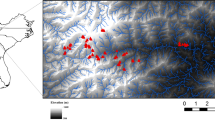Summary
Plethodon richmondi shenandoah occurs in at least three geographically isolated talus slopes in Shenandoah National Park, Virginia, U.S.A., each surrounded by a continuous population of Plethodon c. cinereus in the soil outside the talus. Distributions are contiguous but largely non-overlapping. The talus presents a much drier habitat than does the surrounding soil. Four experiments were designed to test the responses of the two species to moisture and substrate. Although shenandoah lives in a habitat generally drier than that of cinereus, both species choose the wet end of a moisture gradient and do not differ significantly in moisture preference. When given choices between a substrate of rock or soil, the two species respond similarly: neither expresses a preference when both substrates are moist and both choose soil over rock as the substrates dry, showing that substrate preference is based on moisture content and not texture. A third experiment demonstrates that cinereus suffers significantly greater mortality and loss of body water when subjected to a drying rock substrate than when subjected to a soil substrate, since the latter holds moisture longer. Thus the talus most likely presents a greater stress of dehydration to salamanders than does the soil. A fourth experiment shows that when forced to dehydrate, shenandoah survives longer, loses significantly less body water per hour, and withstands a greater loss of body water before death than does cinereus.
The conclusions drawn are that cinereus inhabits areas of deep soil not due to a preference for that substrate but due to the requirement of a moist substrate, and it cannot enter the talus due to the dry conditions there. P. r. shenandoah, on the other hand, neither prefers the rocky nor the dry conditions of the talus and is probably excluded from the soil by the presence of cinereus. The survival of shenandoah in the talus is due, at least in part, to its ability to withstand the stress of dehydration for a longer period than can cinereus.
Similar content being viewed by others
References
Bogert, C. M.: Relative abundance, habitats, and normal thermal levels of some Virginian salamanders. Ecology 33, 16–30 (1952).
Buckman, H. O., Brady, N. C.: The nature and properties of soils, 6th ed. New York: Macmillan Co. 1963.
Cunningham, J. D.: Aspects of the ecology of the Pacific slender salamander, Batrachoseps pacificus, in southern California. Ecology 41, 88–99 (1960).
Hairston, N.: Interspecies competition and its probable influence upon the vertical distribution of Appalachian salamanders of the genus Plethodon. Ecology 32, 266–274 (1951).
Heatwole, H.: Burrowing ability and behavioral responses to desiccation of the salamander, Plethodon cinereus. Ecology 41, 661–668 (1960).
—: Rates of desiccation and rehydration of eggs in a terrestrial salamander, Plethodon cinereus. Copeia 1961, 110–112 (1961).
—: Environmental factors influencing local distribution and activity of the salamander Plethodon cinereus. Ecology 43, 460–472 (1962).
—, Lim, K.: Relation of substrate moisture to absorption and loss of water by the salamander, Plethodon cinereus. Ecology 42, 814–819 (1961).
Highton, R., Worthington, R.: A new salamander of the genus Plethodon from Virginia. Copeia 1967, 617–626 (1967).
Hutchinson, V.: Critical thermal maxima in salamanders. Physiol. Zool. 34, 92–125 (1961).
Jaeger, R. G.: Competitive exclusion between two species of salamanders. Bull. Ecol. Soc. Amer. 49, 168 (1968).
Jaeger, R. G.: Competitive exclusion and environmental tolerances in the distributions of two species of salamanders (genus Plethodon) in Virginia. Ph.D. Dissertation, Univ. of Maryland (1969).
—: Potential extinction through competition between two species of terrestrial salamanders. Evolution 24, 632–642 (1970).
Littleford, R. A., Keller, W. F., Phillips, N. E.: Studies on the vital limits of water loss in the plethodontid salamanders. Ecology 28, 440–447 (1947).
Ray, C.: Vital limits and rates of desiccation in salamanders. Ecology 39, 75–83 (1958).
Rosenthal, G. M.: The role of moisture and temperature in the local distribution of the plethodontid salamander Aneides lugubris. Univ. California Publ. Zool. 54, 371–420 (1957).
Spight, T. M.: The water economy of salamanders: evaporative water loss. Physiol. Zool. 41, 195–203 (1968).
Taub, F. B.: The distribution of the red-backed salamander, Plethodon c. cinereus, within the soil. Ecology 42, 681–698 (1961).
Author information
Authors and Affiliations
Rights and permissions
About this article
Cite this article
Jaeger, R.G. Moisture as a factor influencing the distributions of two species of terrestrial salamanders. Oecologia 6, 191–207 (1971). https://doi.org/10.1007/BF00344914
Received:
Issue Date:
DOI: https://doi.org/10.1007/BF00344914




